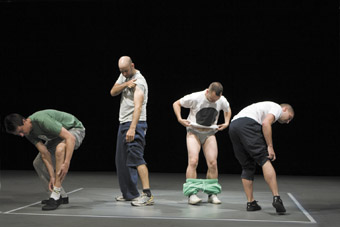 |
Ross Coulter, Simon Obarzanek, Antony Hamilton, Byron Perry, Untrained, Lucy Guerin Inc, photo Belinda: artsphotography.net.au photo Belinda: artsphotography.net.au |
These phenomena resonate, on the one hand, with the immersive media arts and virtual realities of the 21st century and, on the other, with computer game playing and the ongoing surge of popular competition, from quiz shows to reality TV. With none of the latter’s dumbed down Darwinism, Lucy Guerin Inc’s Untrained benignly offers us reality dance—an extended set of tasks that pit two trained dance artists (Byron Perry, Antony Hamilton) against two visual artists (Simon Obarzanek, Ross Coulter)—revealing much about how we perceive the human body and what we think we know about dance.
The ‘reality’ of Untrained, however well constructed the overall work might be, is that the non-dancers’ lack of dance skills provides a considerable likelihood of risk and of chance happenings, moments of surprising verve and sheer failure. Nor are the tasks simple for the trained dancers: there’s a large quotient of improvisation and passages where they have to closely mimic the unpredictable moves of the untrained or interpret their choreographies. As much as these amuse, they’re also telling. The untrained pick up the broad patterns of movement, but rarely the detail (hinged on acute degrees of propulsion, balance and articulation), while the trained briskly realise additional layers of possibility.
So, instead of a finished dance work, we are witness to a series of revealing portraits and tests with a chancy, cumulative impact. Above all, we are implicitly asked to look very closely at, and listen to, these four men, our role as observers considerably heightened. This is accentuated by the spare staging—a large open space with a square marked out in the middle, a frame in which everything happens as soon as the men enter it from the queues they form either side. Initially, each man stands before us, motionless. We take each in. We’ll subsequently see these same faces, these same bodies again, at rest (as if asleep), pulling faces, making weird sounds, reading aloud comments they’ve made about themselves. Towards the end, each of them simply stands before us again, but now we know more about them—not a lot (this is not the confessional faction of reality TV), but details of physiognomy and assessments of mobility, risk-taking, engagement with each other and us. We have guessed at and largely learnt this not from the brief images of the men alone, but from their work together.
There’s even a moment where, with cards and textas, the men stand at the four corners of the frame and sketch each other’s faces, then show the results to the audience. In another, they display photographs of themselves, and elsewhere, videos they’ve directed. They even comment on each other’s dance and visual art capacities. But it’s the dancing itself which is most revealing. One after another the performers execute a move; as the image mutates the effect is of a visual Chinese whisper. More brief moves—balances, kicks, spins, painfully slow motion extensions—ensue and morph. Ross Coulter wittily removes his shoe and uses it puppet-like to mimic a slow motion fall while his body remains at rest. The tasks grow more demanding, if leavened with moments of yawning or sighing, or long jumps, or solo songs or speaking backwards, or performing favourite pop culture figures. The extended copying duets break the frame as each trained performer follows an untrained one around the space and then the roles are reversed—concentration, effort, surprise and amusement are palpable.
These competitive duets tell us much. Obarzanek tries very hard, he’s a bit of a performer (naturally inclined to dance when he sings in his emphatic baritone); Coulter is economical, more low key, laconic, if nonetheless committed. With the trained dancers the differences are subtler; theirs is an easy-going naturalism, the singing more polished, personalities less overtly expressed. Not surprisingly it’s their dancing which is telling: Perry’s spring-loaded, quietly dramatic articulacy, Hamilton’s sinuous, rippling intensity.
As well as the duets, there’s recurrent group work which comes affectingly into its own at the end—where you find yourself wishing that there’d been more of it, as big a demand as that might be. In the course of the show, the group moans, cries and, among other things, demonstrates various, revealing techniques for removing and putting on t-shirts. Above all the men collectively convey an undemonstrative competitiveness, mutual empathy and good humour as they perform their long list of tasks, while the audience doubtlessly reflects on what its own dance abilities might be in the same circumstances.
Perhaps, too, the audience think about the pleasure of witnessing a benign image of men collaborating and competing without corporate, militaristic or sporting straitjacketings. However well or not they can dance, these men flow, as Klaus Theweleit put it in his anti-fascist classic Male Fantasies (1977), and the sense of them as real and complex, beyond artifice, is rooted in the lucid pragmatism of Guerin’s task-based formulation for Untrained.
Lucy Guerin Inc, Untrained, concept, direction Lucy Guerin, performers Ross Coulter, Antony Hamilton, Simon Obarzanek, Byron Perry, music Cusp by Duplo Remote, producer Michaela Coventry; Arts House, March 11-14; Dance Massive, Melbourne, March 3-15
RealTime issue #90 April-May 2009 pg. web
© Keith Gallasch; for permission to reproduce apply to [email protected]








 back
back